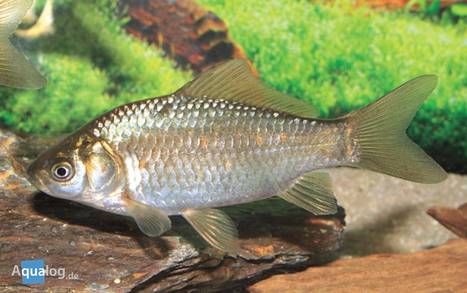To many fish lovers, the goldfish is a brightly coloured fish which is active, but peaceful, is about 5cm long and has a simple, streamlined body shape with large friendly-looking eyes. Yet, the common goldfish that everyone knows is, despite its basic finnage and body shape, at least one step removed from the ‘real’ goldfish.
The natural coloration of the wild goldfish is olive-brown. Other colours may be found in some lowland river locations, small lakes, and backwaters, but these are thought to be the result of introductions of domesticated varieties (although colour variations do exist in true wild stocks). The two best known goldfish relatives are the gibel or Prussian carp (C. gibelio) and the crucian or bronze carp (C. carassius). The goldfish and the gibel carp were once believed to be so closely related as to be subspecies, i.e. C. auratus auratus and C. auratus gibelio. The goldfish is native to China, central Asia, Japan and certain parts of Siberia, while the gibel carp, although also found in western Siberia, is usually reported as being a mainly eastern European fish. The two may be told apart by slight anatomical differences such as the size of the head relative to the body (smaller in the gibel carp), numbers of gill rakers (35- 46 in the goldfish and 39-50 in the gibel carp), fin rays and lateral line scale counts. However, the virtually worldwide introduction of the goldfish into natural bodies of water often clouds the true distribution and nature of many of the populations found in the wild.

The other widely distributed European carp which shares certain similarities with both the goldfish and the gibel carp i.e. the bronze or crucian carp, is also olivebrown, but has a considerably deeper body, a convex outline to its dorsal fin, grows to a larger size – up to 64cm (max), compared to 48cm and 45cm (max) for the other two, respectively – and has different fin ray and gill raker counts. When the gibel carp became recognized as a species in its own right, i.e. C. gibelio, most people then assumed that the goldfish, too, was a full species, i.e. C. auratus.However, the situation is not quite as straightforward as this.

The wide distribution of the goldfish, along with its in-built ‘plasticity’, which
results in slightly different forms depending on location and conditions, has resulted in numerous ‘species’ and ‘subspecies’ being described over the years. In fact, by 1945, there were 42 different official descriptions of the goldfish and goldfish-type fishes! Since then, these have been systematically reduced to just four species, one of which, C. auratus, is subdivided into five subspecies. If this latest trend is correct…and if we feel able to accept it and want to be really up to date…we should therefore be recognising the common goldfish as a subspecies: C. auratus auratus. The full current FishBase listing for Carassius is:
C. auratus argenteaphthalmus (No common name)
C. auratus auratus (Goldfish, Kin-buna*)
C. auratus buergeri (Naga-buna*)
C. auratus grandoculis (Nigoro-buna*)
C. auratus langsdorfii (Gin-buna*)
C. carassius (Crucian or Bronze Carp)
C. cuvieri (Japanese or White Crucian Carp)
C. gibelio (Gibel or Prussian Carp)

The names indicated by an asterisk (*) are the Japanese names for these fish. With the exception of the goldfish, these asterisked subspecies have almost exclusively Japanese distributions and are little-known, even within Japan itself.One, C. auratus grandoculis, has a particularly restricted distribution, occurring only in Lake Biwa. C. auratus argenteaphthalmus, the most recently described subspecies (Nguyen, 2001), comes from Viet Nam and is even more poorly known. The only subspecies of C. auratus that most of us are ever likely to encounter is the common goldfish, which we’ll undoubtedly continue to refer to as we’ve always done i.e. as Carassius auratus. One thing we are most unlikely to do, at least, in Europe, is to use any common name other than ‘the goldfish’…not like the Malaysians who also refer to C. auratus as the edible goldfish…or the Kazakhstanis who, confusingly, call it the gibel carp(!)…or the Taiwanese who label it (even more confusingly) as the golden crucian carp!

Anzeige






